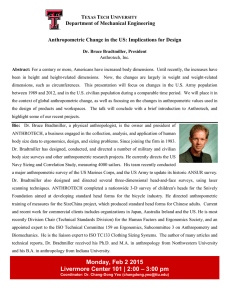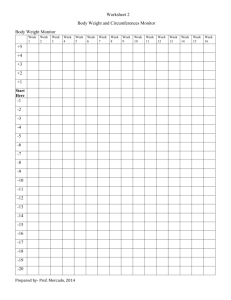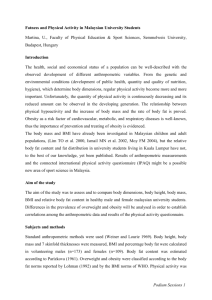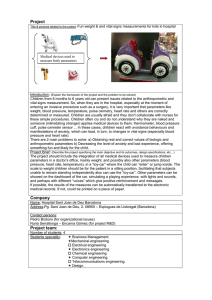Document 13309300
advertisement
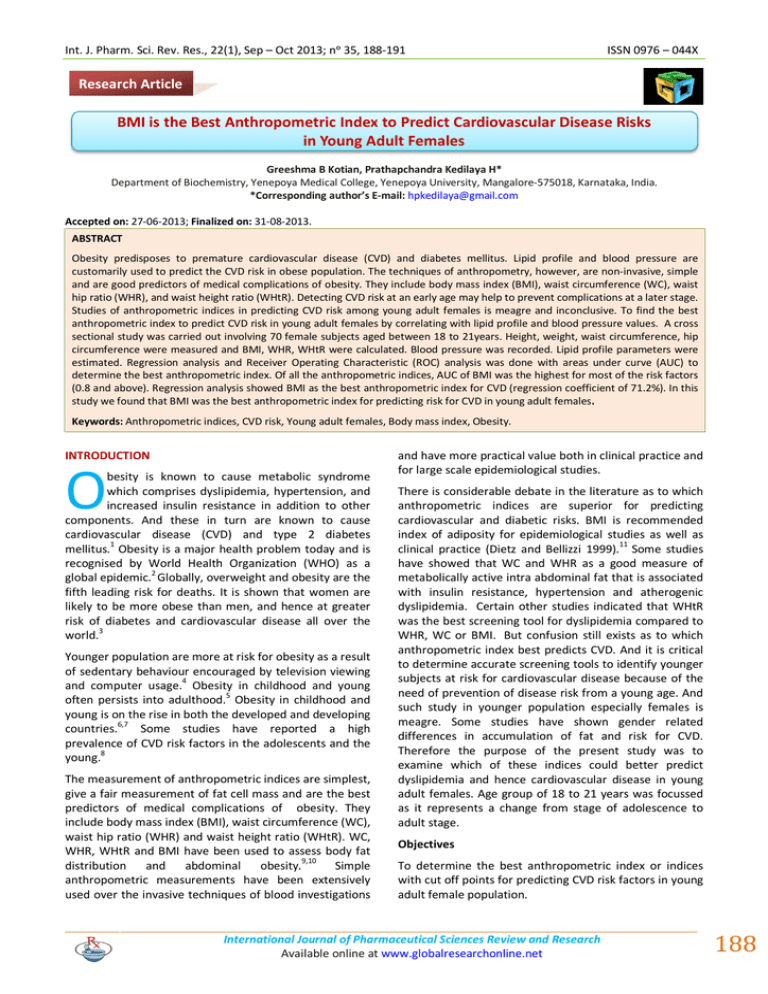
Int. J. Pharm. Sci. Rev. Res., 22(1), Sep – Oct 2013; nᵒ 35, 188-191 ISSN 0976 – 044X Research Article BMI is the Best Anthropometric Index to Predict Cardiovascular Disease Risks in Young Adult Females Greeshma B Kotian, Prathapchandra Kedilaya H* Department of Biochemistry, Yenepoya Medical College, Yenepoya University, Mangalore-575018, Karnataka, India. *Corresponding author’s E-mail: hpkedilaya@gmail.com Accepted on: 27-06-2013; Finalized on: 31-08-2013. ABSTRACT Obesity predisposes to premature cardiovascular disease (CVD) and diabetes mellitus. Lipid profile and blood pressure are customarily used to predict the CVD risk in obese population. The techniques of anthropometry, however, are non-invasive, simple and are good predictors of medical complications of obesity. They include body mass index (BMI), waist circumference (WC), waist hip ratio (WHR), and waist height ratio (WHtR). Detecting CVD risk at an early age may help to prevent complications at a later stage. Studies of anthropometric indices in predicting CVD risk among young adult females is meagre and inconclusive. To find the best anthropometric index to predict CVD risk in young adult females by correlating with lipid profile and blood pressure values. A cross sectional study was carried out involving 70 female subjects aged between 18 to 21years. Height, weight, waist circumference, hip circumference were measured and BMI, WHR, WHtR were calculated. Blood pressure was recorded. Lipid profile parameters were estimated. Regression analysis and Receiver Operating Characteristic (ROC) analysis was done with areas under curve (AUC) to determine the best anthropometric index. Of all the anthropometric indices, AUC of BMI was the highest for most of the risk factors (0.8 and above). Regression analysis showed BMI as the best anthropometric index for CVD (regression coefficient of 71.2%). In this study we found that BMI was the best anthropometric index for predicting risk for CVD in young adult females. Keywords: Anthropometric indices, CVD risk, Young adult females, Body mass index, Obesity. INTRODUCTION O besity is known to cause metabolic syndrome which comprises dyslipidemia, hypertension, and increased insulin resistance in addition to other components. And these in turn are known to cause cardiovascular disease (CVD) and type 2 diabetes mellitus.1 Obesity is a major health problem today and is recognised by World Health Organization (WHO) as a global epidemic.2 Globally, overweight and obesity are the fifth leading risk for deaths. It is shown that women are likely to be more obese than men, and hence at greater risk of diabetes and cardiovascular disease all over the world.3 Younger population are more at risk for obesity as a result of sedentary behaviour encouraged by television viewing and computer usage.4 Obesity in childhood and young often persists into adulthood.5 Obesity in childhood and young is on the rise in both the developed and developing 6,7 countries. Some studies have reported a high prevalence of CVD risk factors in the adolescents and the 8 young. The measurement of anthropometric indices are simplest, give a fair measurement of fat cell mass and are the best predictors of medical complications of obesity. They include body mass index (BMI), waist circumference (WC), waist hip ratio (WHR) and waist height ratio (WHtR). WC, WHR, WHtR and BMI have been used to assess body fat distribution and abdominal obesity.9,10 Simple anthropometric measurements have been extensively used over the invasive techniques of blood investigations and have more practical value both in clinical practice and for large scale epidemiological studies. There is considerable debate in the literature as to which anthropometric indices are superior for predicting cardiovascular and diabetic risks. BMI is recommended index of adiposity for epidemiological studies as well as clinical practice (Dietz and Bellizzi 1999).11 Some studies have showed that WC and WHR as a good measure of metabolically active intra abdominal fat that is associated with insulin resistance, hypertension and atherogenic dyslipidemia. Certain other studies indicated that WHtR was the best screening tool for dyslipidemia compared to WHR, WC or BMI. But confusion still exists as to which anthropometric index best predicts CVD. And it is critical to determine accurate screening tools to identify younger subjects at risk for cardiovascular disease because of the need of prevention of disease risk from a young age. And such study in younger population especially females is meagre. Some studies have shown gender related differences in accumulation of fat and risk for CVD. Therefore the purpose of the present study was to examine which of these indices could better predict dyslipidemia and hence cardiovascular disease in young adult females. Age group of 18 to 21 years was focussed as it represents a change from stage of adolescence to adult stage. Objectives To determine the best anthropometric index or indices with cut off points for predicting CVD risk factors in young adult female population. International Journal of Pharmaceutical Sciences Review and Research Available online at www.globalresearchonline.net 188 Int. J. Pharm. Sci. Rev. Res., 22(1), Sep – Oct 2013; nᵒ 35, 188-191 MATERIALS AND METHODS ISSN 0976 – 044X each ROC curve, which is a measure to identify subjects with risk factors. Subjects The study involved 70 female students in the age group of 18-21yrs. Permission for conduction of this study was obtained from the Ethical Committee of our Institution (Yenepoya University). Informed consent was taken from the subjects who participated in the study after explaining the aim of the study and the kind of measurements. All the subjects selected were nulliparous with no history of diabetes, hypertension, endocrinal disorders or menstrual irregularities. The subjects were advised to come after 10 hrs of overnight fast. RESULTS AND DISCUSSION Both regression analysis and ROC analysis indicated that BMI by far is the best index for predicting dyslipidemia (table 1). The AUC of anthropometric indices are shown in table 2. The cut off points that maximised sensitivity and specificity for dyslipidemia is given in table 3. Table 1: Regression coefficients to indicate the best anthropometric index for CVD risk factors Anthropometric Indices Regression Coefficient Anthropometry BMI 71.2% Body weight, height, waist circumference and hip circumference were recorded by the same observer. Subjects were weighed on a weighing scale barefooted. Height was measured barefooted with head in horizontal plane to the nearest 0.5cm. Waist circumference (midway between the lower rib margin and the iliac crest at the end of normal expiration) and hip circumference (widest diameter over the greater trochanter) were measured to the nearest 0.1cm in standing position using a tape. BMI was calculated as weight (kg) divided by height in meter squared (m2). Waist to hip ratio (WHR) was also calculated as WC divide by HC. Waist to height ratio calculated as WC divided by height. Blood pressure was recorded in the right arm using sphygmomanometer after the subject has rested for 5min and in upright position. Two readings at 5 min intervals were taken from each participant. The lower of 2 readings was recorded as subject’s blood pressure. WC 42.6% WHR 13.7% WHtR 45.2% BMI- Body mass index, WC - Waist circumference, WHR- Waist hip ratio, WHtR – Waist height ratio Table 2: AUC for best anthropometric index for CVD risk factors AUC Risk Factor BMI WC WHR WHtR Best Anthropometric Index LDL-C 0.890 0.774 0.594 0.764 BMI HDL-C 0.981 0.864 0.646 0.881 BMI NON-HDL-C 0.735 0.610 0.547 0.592 BMI TG 0.838 0.783 0.664 0.839 BMI & WHtR Non-HDLC/HDL-C 0.799 0.707 0.588 0.696 BMI Biochemical parameters LDL-C/HDL-C 0.929 0.862 0.770 0.871 BMI Five ml of overnight fasting blood samples were obtained from each subject. The blood was collected in vacutainers with no added anticoagulant and serum separated within 1 hour. Total cholesterol (TC), HDL-cholesterol (HDL-C), Triglycerides (TG), direct LDL-cholesterol (LDL-C) were determined using commercially available kits (SPAN Diagnostics). Non-HDL-cholesterol (non-HDL-C) was calculated by subtracting HDL-C from total cholesterol as non-HDL-C is increasingly being used in clinical research 12,13 as an index of CVD risk. The atherogenic indices such as LDL-C/HDL-C and non-HDL-C/HDL-C were calculated. LDL-C – Low density lipoprotein-cholesterol, HDL-C- High density lipoprotein-cholesterol, TG – Triglycerides Statistical analysis Regression analysis and receiving operating curve (ROC) were the statistical methods used to compare anthropometric indices to predict CVD risks. ROC was used to find the cut off values for anthropometric indices. The optimal cut off value for each index was indicated by the value that showed the largest sum of sensitivity and specificity (>80%). Measures of sensitivity and 1―specificity were used for plo ng the ROC curve for each anthropometry cut off value. Area under curve (AUC) was used to evaluate the overall performance of Table 3: Cut off values of anthropometric indices for CVD risk factors Risk Factor Cut-Off Values BMI WC WHR WHtR LDL-C 24.93 82.5 0.86 0.52 HDL-C 25.1 83.5 0.86 0.54 NON-HDL-C 24.9 82.5 0.85 0.52 TG 23.2 82.5 0.85 0.54 Non-HDL-C/HDL-C 23.3 82.5 0.85 0.54 LDL-C/HDL-C 23.4 83.5 0.85 0.55 BMI- Body mass index, WC - Waist circumference, WHR- Waist hip ratio, WHtR – Waist height ratio, LDL-C – Low density lipoprotein-cholesterol, HDL-C- High density lipoprotein-cholesterol, TG – Triglycerides Different studies have given varying conclusions about which anthropometric measure has the best predictive capacity for CVD risk factors. It has been shown that age modifies the discriminative ability of anthropometric indices to identify subjects with CVD risk factors. Also studies have shown that anthropometric measures International Journal of Pharmaceutical Sciences Review and Research Available online at www.globalresearchonline.net 189 Int. J. Pharm. Sci. Rev. Res., 22(1), Sep – Oct 2013; nᵒ 35, 188-191 perform differently for the prediction of disease risk in diverse ethnic and geographic populations14-16. Therefore, it has been suggested that using anthropometric indices for CVD risk screening needs specific studies in different ages and in populations of varied ethnic backgrounds. The Iowa’s Women Health Study reported that overweight and obese women with a high WC (>88cms) face a greater risk of CVD related deaths when compared with overweight and obese women with a normal WC 17 (<88cm) . However the study evaluated only postmenopausal women, unlike our study where we evaluated only young adult females of 18-20 years. Although WC, WHR are considered to be measures of identifying subjects at increased risk for metabolic syndrome, because of central fat distribution, only small amounts of intra-abdominal fat are physiologically present before adulthood18. And also, waist circumference has not yet been validated as an index of intra-abdominal fat during puberty. Further, some studies suggest gender related differences in the rate of accumulation of abdominal adiposity with 19 advancing age . Thus a given increment in BMI in a young population has more negative implications for future disease risk than a similar increment among older individuals, indicating BMI as an important index in the young. Our present study also clearly indicated that BMI was the best anthropometric index to predict dyslipidemia and hence CVD risk in young adult females. The cut off values for BMI in this study corresponded to that recommended by the WHO. REFERENCES 1. Yong-Hao PUA, Peck-Hoon ONG, Anthropometric indices as screening tools for cardiovascular risk factors in Singaporean women. Asia Pacific Journal of Clinical Nutrition, 14 (1), 2005, 74-79. 2. Chopra M, Galbraith S Darnton-Hill I, A global response to a global problem. The epidemic of overnutrition, Bull world health organization, 80, 2002, 952-958. 3. Swati DhruV, Uma IyeR, Kusum Bhatt, Assessment of cardio-metabolic risk factors among young adult females, American Journal of Infectious Diseases, 8 (1), 2012, 34-40. 4. Rey- Lopez JP, Vincente Rodriguez G, Biosca M, Moreno LA, Sedentary behaviour and obesity development in children and adolescents, Nutrition, Metabolism & Cardiovascular Diseases, 18 (3), 242-5. 5. World Health Organization Obesity and overweight: World Health Organization global strategy on diet, physical activity and health fact sheet (accessed Sept 16, 2005), 2003, http// www.who.int/. 6. Gupta R, Goyle A, Kashyap S, Agarwal M, Consul R, Jain BK, Prevalence of atherosclerosis risk factor in adolescent school children, Indian Heart Journal, 50, 1998 511-515. 7. Vikram NK, Misra A, Dwivedi M, Sharma R, Pandey RM, Luthra K, Chatterjee A, Dhingra V, Jailkhani BL, Talwar KK, Guleria R, Correlations of C-reactive protein levels with anthropometric profile, percentage of body fat and lipids in healthy adolescents and young adults in urban North India, Atherosclerosis, 168, 2003, 305-313. 8. Rajeev Gupta, Anoop Misra, Naval K Vikram, Dimple Kondal, Shaon Sen Gupta, Aachu Agrawal, RM Pandey, Younger age of escalation of cardiovascular risk factors in Asian Indian subjects, BMC Cardiovascular Disorders, 9, 2009, 28. 9. Hsieh SD, Yoshinaga H and Minto T, Waist-to-height ratio a simple and practical index for assesing central fat distribution and metabolic risk in Japanese men and women, International Journal of Obesity Related Metabolic Disorders ,27, 2003, 610-616. CONCLUSION The measurement of anthropometric indices is noninvasive and simple; and the indices are good predictors of medical complications of obesity. These anthropometric indices have been extensively used over the invasive techniques of blood investigations and allow medical and public health practitioners to identify those at highest risk and reduce the burden of chronic disease at a later age, by allowing individuals to undergo dietary and lifestyle changes. This early screening could provide benefit to the individuals to avoid CVD at later ages. Our present study clearly showed that BMI was the best anthropometric index among others to predict dyslipidemia and hence CVD risk in young adult females. Further Research BMI may be the best screening tool for Indian young females but such a conclusion awaits further verification in longitudinal epidemiological studies on morbidity and mortality. Acknowledgement: We acknowledge medical and dental students of Yenepoya University, who were the subjects of our study. ISSN 0976 – 044X 10. Misra A and Vikram N, Clinical and pathophysiological consequences of abdominal adiposity and abdominal adipose tissue depots, Nutrition, 19, 2003, 457-466. 11. C Maffeis, N Corcinlo, C Livieri, I Rabbone, G Trifero, A Falorni, L Guerraggio, P Peverelli, G Cuccarolo, G Bergamaschi, M Di Petro and A Grezzani, Waist circumference as a predictor of cardiovascular and metabolic risk factors in obese girls, European Journal of Clinical Nutrition, 57, 2003, 566-572. 12. Sathanur R. Srinivasan, Leann Myers, Gerald S. Berenson, Distribution and Correlates of Non-High-Density Lipoprotein Cholesterol in Children: The Bogalusa Heart Study, Pediatrics Vol 110, No. 3, September 2002. 13. Wei Fen Zhu, Li Liang , Chun Lin Wang, Jun Fen Fu, Triglyceride and Non-High-Density Lipoprotein Cholesterol as Predictors of Cardiovascular Disease Risk Factors in Chinese Han Children, Indian Pediatrics 2013, Apr 8, 50 (4), 394-8. 14. Lynnette M Neufeld, Jessica C Jones Smith, Raquel Garcia, Lia CH Fernald, Anthropometric predictors for risk of International Journal of Pharmaceutical Sciences Review and Research Available online at www.globalresearchonline.net 190 Int. J. Pharm. Sci. Rev. Res., 22(1), Sep – Oct 2013; nᵒ 35, 188-191 chronic disease in non diabetic, non hypertensive young Mexican women, Public Health Nutrition, 11(2), 159-167. 15. Lin WY, Lee LT, Chen CY, Lo H, Hsia HH, Liu IL, Lin RS, Shau WY, Huang KC. . Optimal cut off values for obesity using simple anthropometric indices to predict cardiovascular risk factors in Taiwan, International Journal of Obesity and related metabolic disorders,26(9), 2002, 1232-8. 16. Zhu S, Wang Z, Hishka S, Hao M, Faith MS, Heymsfield B, Waist circumference and obesity associated risk factors among whites in the third National Health and Nutrition Examination Survey clinical actione thresholds, American Journal of clinical nutrition, 76(40), 2002, 743-9. ISSN 0976 – 044X 17. Folsom AR, Kushi LH, Anderson KT et al, Associations of general and abdominal obesity with multiple health outcomes in older women, The IOWA Womens Health study, Archives of International Medicine, 160, 2000, 211728. 18. Mathew S, Freiberg, Michael J Penana, Ralph B D Agostino, Katherine Lanier, Peter W.F. Wilson, Ramachandran S. Vasan, Obesity 16(20), 2008, 463-69. 19. Misra A. Revisions of cut offs of body mass index to define overweight and obesity are needed for the Asian ethnic groups, International Journal of Obesity Related Metabolic Disorders,27, 2003, 1294-96. Source of Support: Nil, Conflict of Interest: None. International Journal of Pharmaceutical Sciences Review and Research Available online at www.globalresearchonline.net 191
